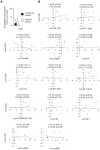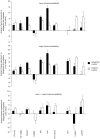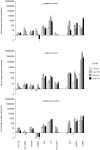Expression profiling of major histocompatibility and natural killer complex genes reveals candidates for controlling risk of graft versus host disease
- PMID: 21305040
- PMCID: PMC3030590
- DOI: 10.1371/journal.pone.0016582
Expression profiling of major histocompatibility and natural killer complex genes reveals candidates for controlling risk of graft versus host disease
Abstract
Background: The major histocompatibility complex (MHC) is the most important genomic region that contributes to the risk of graft versus host disease (GVHD) after haematopoietic stem cell transplantation. Matching of MHC class I and II genes is essential for the success of transplantation. However, the MHC contains additional genes that also contribute to the risk of developing acute GVHD. It is difficult to identify these genes by genetic association studies alone due to linkage disequilibrium in this region. Therefore, we aimed to identify MHC genes and other genes involved in the pathophysiology of GVHD by mRNA expression profiling.
Methodology/principal findings: To reduce the complexity of the task, we used genetically well-defined rat inbred strains and a rat skin explant assay, an in-vitro-model of the graft versus host reaction (GVHR), to analyze the expression of MHC, natural killer complex (NKC), and other genes in cutaneous GVHR. We observed a statistically significant and strong up or down regulation of 11 MHC, 6 NKC, and 168 genes encoded in other genomic regions, i.e. 4.9%, 14.0%, and 2.6% of the tested genes respectively. The regulation of 7 selected MHC and 3 NKC genes was confirmed by quantitative real-time PCR and in independent skin explant assays. In addition, similar regulations of most of the selected genes were observed in GVHD-affected skin lesions of transplanted rats and in human skin explant assays.
Conclusions/significance: We identified rat and human MHC and NKC genes that are regulated during GVHR in skin explant assays and could therefore serve as biomarkers for GVHD. Several of the respective human genes, including HLA-DMB, C2, AIF1, SPR1, UBD, and OLR1, are polymorphic. These candidates may therefore contribute to the genetic risk of GVHD in patients.
Conflict of interest statement
Figures








Similar articles
-
Correlation of Hsp70-1 and Hsp70-2 gene expression with the degree of graft-versus-host reaction in a rat skin explant model.Transplantation. 2008 Jun 27;85(12):1809-16. doi: 10.1097/TP.0b013e31817753f7. Transplantation. 2008. PMID: 18580475
-
Skin explant model of human graft-versus-host disease: prediction of clinical outcome and correlation with biological risk factors.Biol Blood Marrow Transplant. 2006 Feb;12(2):152-9. doi: 10.1016/j.bbmt.2005.09.018. Biol Blood Marrow Transplant. 2006. PMID: 16443513 Clinical Trial.
-
MHC haplotype matching for unrelated hematopoietic cell transplantation.PLoS Med. 2007 Jan;4(1):e8. doi: 10.1371/journal.pmed.0040008. PLoS Med. 2007. PMID: 17378697 Free PMC article.
-
Immunogenomics of hematopoïetic stem cell transplantation.Transfus Clin Biol. 2003 Jun;10(3):156-8. doi: 10.1016/s1246-7820(03)00045-4. Transfus Clin Biol. 2003. PMID: 12798849 Review.
-
Acute graft-vs-host disease: pathobiology and management.Exp Hematol. 2001 Mar;29(3):259-77. doi: 10.1016/s0301-472x(00)00677-9. Exp Hematol. 2001. PMID: 11274753 Review.
Cited by
-
Pathophysiology of GvHD and Other HSCT-Related Major Complications.Front Immunol. 2017 Mar 20;8:79. doi: 10.3389/fimmu.2017.00079. eCollection 2017. Front Immunol. 2017. PMID: 28373870 Free PMC article. Review.
-
Proteomics Revealed That Mitochondrial Function Contributed to the Protective Effect of Herba Siegesbeckiae Against Cardiac Ischemia/Reperfusion Injury.Front Cardiovasc Med. 2022 Jul 6;9:895797. doi: 10.3389/fcvm.2022.895797. eCollection 2022. Front Cardiovasc Med. 2022. PMID: 35872903 Free PMC article.
-
Predicting survival using clinical risk scores and non-HLA immunogenetics.Bone Marrow Transplant. 2015 Nov;50(11):1445-52. doi: 10.1038/bmt.2015.173. Epub 2015 Jul 27. Bone Marrow Transplant. 2015. PMID: 26214138
-
Immune reconstitution and graft-versus-host reactions in rat models of allogeneic hematopoietic cell transplantation.Front Immunol. 2012 Nov 30;3:355. doi: 10.3389/fimmu.2012.00355. eCollection 2012. Front Immunol. 2012. PMID: 23226148 Free PMC article.
-
Unraveling the Mechanisms of Cutaneous Graft-Versus-Host Disease.Front Immunol. 2018 May 2;9:963. doi: 10.3389/fimmu.2018.00963. eCollection 2018. Front Immunol. 2018. PMID: 29770141 Free PMC article. Review.
References
-
- Dickinson AM, Middleton PG, Rocha V, Gluckman E, Holler E. Genetic polymorphisms predicting the outcome of bone marrow transplants. Br J Haematol. 2004;127:479–490. - PubMed
-
- Flomenberg N, Baxter-Lowe LA, Confer D, Fernandez-Vina M, Filipovich A, et al. Impact of HLA class I and class II high-resolution matching on outcomes of unrelated donor bone marrow transplantation: HLA-C mismatching is associated with a strong adverse effect on transplantation outcome. Blood. 2004;104:1923–1930. - PubMed
-
- Dickinson AM. Non-HLA genetics and predicting outcome in HSCT. Int J Immunogenet. 2008;35:375–380. - PubMed
Publication types
MeSH terms
Substances
Grants and funding
LinkOut - more resources
Full Text Sources
Molecular Biology Databases
Research Materials
Miscellaneous

